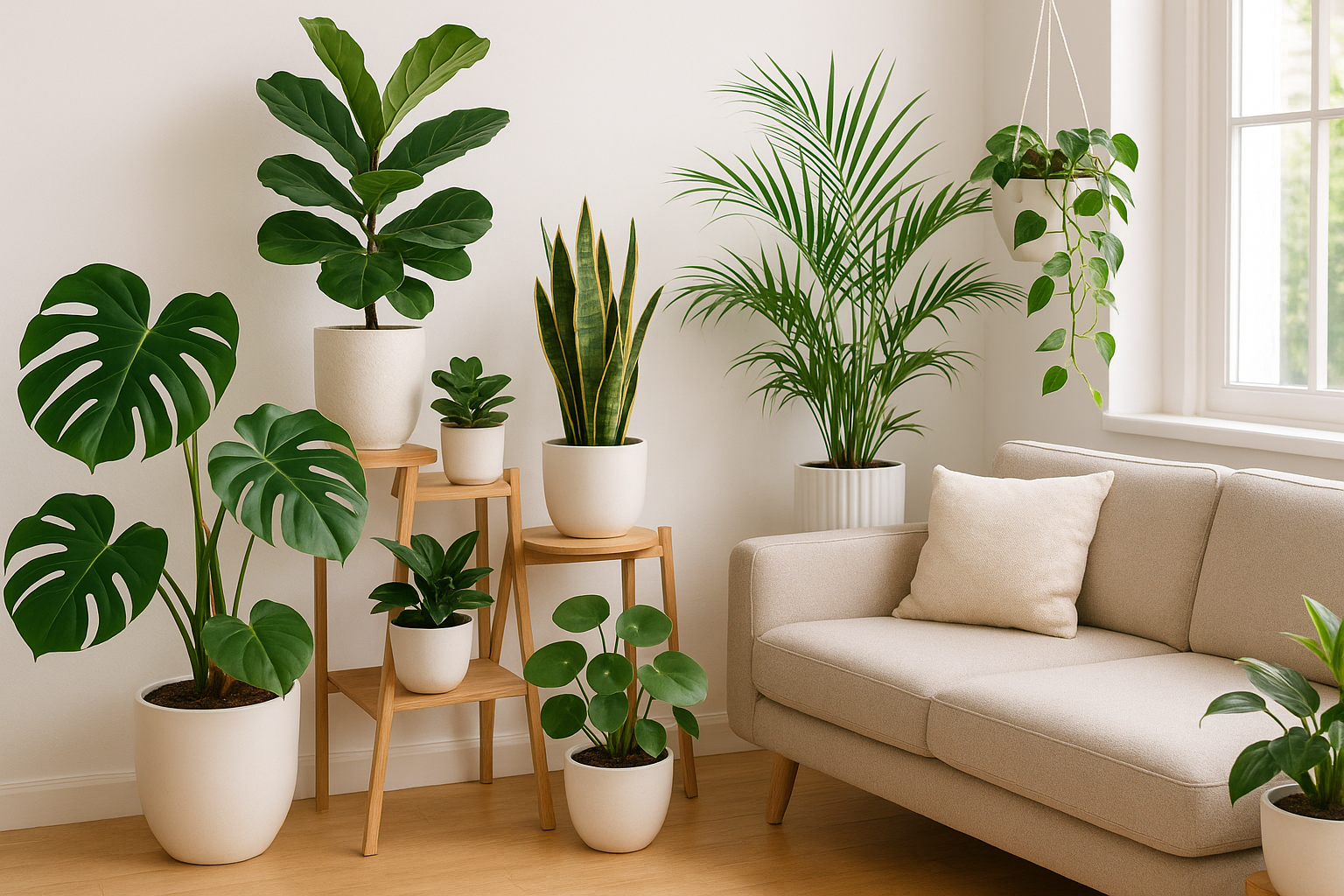1. Why Houseplants Matter
Benefits of Indoor Plants
Air Purification: NASA research shows that some plants remove toxins like formaldehyde and benzene.
Mental Health Boost: Caring for plants can reduce stress and anxiety, and increase focus.
Aesthetic Value: They enhance interior design with color, structure, and life.
Humidity Control: Certain plants naturally add moisture to the air—especially helpful in winter.
2. Choosing the Best Houseplants by Light, Space, and Lifestyle
Not all houseplants thrive everywhere. The right plant depends on your conditions, not just what’s trending on Instagram.
Low-Light Tolerant Plants
Perfect for apartments or rooms with north-facing windows:
Snake Plant (Sansevieria): Nearly indestructible; grows upright with architectural lines.
ZZ Plant (Zamioculcas zamiifolia): Glossy leaves; drought-tolerant.
Pothos (Epipremnum aureum): Trailing vine; thrives in indirect light.
Philodendron: Heart-shaped leaves and great vining behavior.
Bright Light / Sunny Spot Plants
South or west-facing windows are ideal:
Fiddle Leaf Fig (Ficus lyrata): Bold and dramatic, though finicky.
Succulents & Cacti: Require direct sunlight and minimal water.
Bird of Paradise (Strelitzia): Large, tropical leaves with height.
Areca Palm: A softer, feathery touch with air-purifying benefits.
Pet-Friendly Plants
If you have cats or dogs, avoid toxic varieties. Choose:
Spider Plant
Calathea
Areca Palm
Peperomia
Compact Plants for Small Spaces
Air Plants (Tillandsia): Soil-free and great in glass orbs.
Miniature Ferns: Perfect for bathrooms.
Baby Rubber Plant (Peperomia obtusifolia): Compact and lush.
3. Essential Houseplant Care Tips
Even hardy houseplants die if neglected or over-loved. Here’s how to avoid the common pitfalls:
Watering
Overwatering is the #1 killer.
Rule of thumb: Check soil moisture with your finger. Water only when the top 1-2 inches are dry.
Use pots with drainage holes.
Light
Observe how much sunlight your room gets.
Bright indirect light = light that doesn’t touch the plant directly but fills the room.
Use grow lights in dark spaces.
Humidity
Tropical plants need 50–60% humidity.
Use a humidifier or place plants on pebble trays.
Bathrooms and kitchens are naturally more humid.
Fertilizing
Feed during growing season (spring and summer) with a balanced liquid fertilizer.
Cut back or stop feeding in fall and winter.
Repotting
Repot when roots start growing out of the drainage holes.
Use fresh potting mix every 1–2 years.
4. Diagnosing Plant Problems
Healthy plants are green and firm. If something looks off, here’s what to check:
| Symptom | Likely Cause |
|---|---|
| Yellow Leaves | Overwatering, poor drainage |
| Brown Tips | Low humidity, salt build up |
| Wilting | Underwatering or root rot |
| Leggy Growth | Insufficient light |
| Leaf Drop | Sudden environment changes |
Pro tip: Don’t panic. Most issues can be corrected before it's too late.
5. Interior Plant Design Ideas
Great plant design enhances your space, not clutters it. Here's how to style like a pro.
Statement Plants
Use large plants like Fiddle Leaf Fig, Monstera, or Bird of Paradise as focal points in living rooms or entryways.
Choose sculptural planters to match your décor style (e.g., terracotta for boho, matte white for modern).
Plant Shelves & Ladders
Mix trailing plants (like Pothos or String of Pearls) with upright ones.
Add height variation using stands or stackable pots.
Bathroom Jungle
Use humidity-loving plants like Boston Fern, Peace Lily, and Calathea.
Hang spider plants from the shower curtain rod.
Green Corners
Combine 3–5 plants of different sizes and textures for visual interest.
Place them in odd-number groupings.
Hanging Plants
Macramé hangers or wall-mounted planters are perfect for vines.
Keep at eye level or higher for best visual balance.
Terrariums & Tabletop Displays
Great for desks or coffee tables.
Use moss, stones, and mini succulents or air plants.
6. Trendy Houseplants in 2025
Some classics never fade, but each year brings fresh favorites.
Current Trending Plants
Monstera Thai Constellation: Variegated beauty, high value.
Alocasia 'Polly': Striking arrow-shaped leaves.
Raven ZZ Plant: Deep black foliage.
Hoya: Wax-like leaves and fragrant flowers.
Silver Satin Pothos: Shimmery, velvety texture.
7. Smart Gardening: Tech Tools and Automation
Tech makes it easier to keep plants alive:
Moisture meters: Know exactly when to water.
Self-watering pots: Useful for busy or forgetful owners.
Plant care apps: “Planta,” “Greg,” or “PictureThis” help track watering schedules and diagnose issues.
Smart grow lights: Set on timers to simulate daylight.
8. Creating a Personalized Indoor Oasis
The best indoor plant setups reflect your lifestyle and taste:
Minimalist? Use fewer plants, neutral pots, and clean lines.
Bohemian? Mix textures, colors, and let plants spill everywhere.
Modern industrial? Use metal and concrete planters with structural greenery.
Coastal? Go for palm varieties and bright pots.
9. Houseplant Design by Room
| Room | Best Plants | Design Tip |
|---|---|---|
| Living Room | Monstera, Snake Plant | Statement plant near windows |
| Bedroom | Peace Lily, Aloe Vera | Air-purifying and calming |
| Kitchen | Herbs, Spider Plant | Use windowsills or wall planters |
| Bathroom | Ferns, Calathea | Humidity lovers thrive here |
| Office | ZZ Plant, Rubber Plant | Minimal maintenance, clean look |
10. Final Thoughts: Make Plants Work for You
Adding houseplants to your home isn’t just about decoration—it’s about creating a living, breathing environment that supports wellness, creativity, and comfort. The trick isn’t to have the most plants; it’s to pick the right ones and care for them consistently.
Start with one plant. Learn its quirks. Then expand. Don’t follow trends blindly—build your personal indoor garden, one plant at a time.
